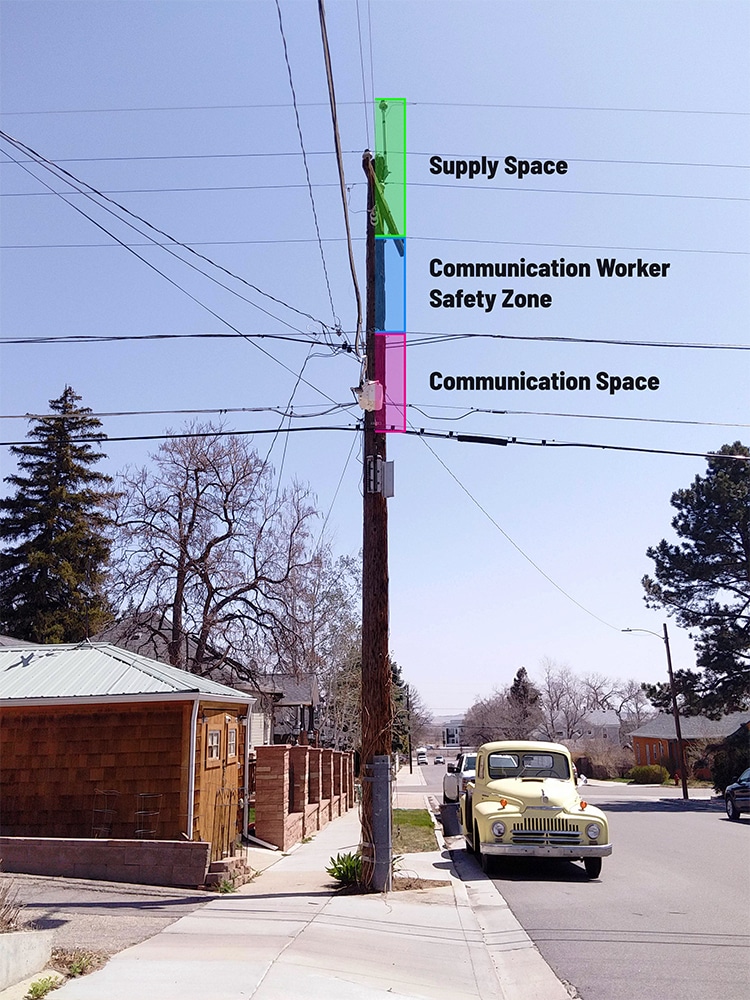The PoleOS™ Company
What is the Communication Worker Safety Zone?
In the world of utility infrastructure, joint-use poles serve as critical support structures for both power and communication lines. A key aspect of these poles is the communication worker safety zone, which plays a crucial role in ensuring the safety of workers who maintain and repair communication equipment. This article dives into the intricacies of measuring clearances on joint-use utility poles.

National Electrical Safety Code (NESC) Guidelines
The NESC provides comprehensive guidelines for establishing clearances between power and communication equipment on utility poles. Two primary rules govern these clearances:
- Rule 235C: Addresses vertical clearances for wires, conductors, and cables on the same supporting structures.
- Rule 238: Covers vertical clearances between communications and supply equipment and facilities.
Together, these rules define the communication worker safety zone, a space that separates communication equipment from power supply lines. This zone creates room on the pole for the communication worker to do their work without coming into contact with the power above, which may be energized at tens of thousands of volts. The communication worker safety zone is often 40 inches, but the NESC allows less than 40 inches for certain types of wires and equipment and requires more than 40 inches for other configurations.
Defining Equipment for Clearance Measurements
NESC Rule 238A provides specific definitions for equipment when measuring clearances:
- For supply (power) equipment: Non-current carrying metal parts of equipment are considered.
- For communication equipment: Both metal and non-metallic supports or braces associated with communication cables and conductors are included.
This distinction is crucial when determining the top of the communication space and the bottom of the supply space.
Measuring Clearances on Crossarms
When measuring clearances for communication cables on crossarms, it’s essential to consider the highest point of communication equipment, not just the cable itself. This includes:
- The bolt through the crossarm holding the cable
- The top of the hardware supporting the cable, for example the three-bolt clamp
- The braces bolted to the crossarm
The highest communication cable or equipment is the top of the communication space, and vertical clearances to the lowest power conductor or equipment must be maintained.
Exceptions in the Safety Zone
While the communication worker safety zone is generally a restricted area, there are some exceptions:
- Span wires or brackets carrying luminaires and traffic signals
- Drip loops associated with light fixtures or traffic signals
- Vertical risers for transitioning from overhead to underground systems
Minimum Approach Distances
In addition to the safety zone, communication workers must adhere to minimum approach distances:
- Unqualified workers: Must maintain a 10-foot distance from energized equipment
- Qualified workers: Can work closer, with specific distances based on voltage levels (e.g., 2 feet 3 inches for a 12.5 kV phase-to-phase line). Qualified communication workers must understand and follow the OSHA 1910.268 Telecommunications standard and Part 4 of the NESC.
Conclusion
Understanding the nuances of measuring clearances and defining safety zones on joint-use utility poles is crucial for ensuring worker safety and compliance with NESC guidelines. By properly identifying equipment boundaries and adhering to established clearance rules, utilities and communication companies can maintain a safe working environment for all personnel involved in pole maintenance and repairs.
Know the Code. Stay safe.
Learn more about NESC and OSHA training classes with IKE
Grant Glaus is a registered professional electrical engineer with 25 years of experience in electric utility engineering, including line design, planning studies, joint use, and teaching NESC®, OSHA, and distribution line design classes. He has served on NESC® Subcommittee 5, Overhead Lines – Strengths and Loadings since 2006.
The latest from the IKE Wire
Safety and speed in pole data collection
Data collection is at the heart of building and maintaining our power and communicati...
Read MoreMy message for Fiber Connect goers: Now is the time to tackle inefficiencies in deployment processes
Last week, I spent a busy few days in Nashville for the Fiber Broadband Association�...
Read MoreVideo Chat: Challenges and Opportunities for Power Delivery Leaders (Part 1)
Overview Energy industry expert and author, Peter Kelly-Detwiler, moderates a discuss...
Read MoreSubscribe to the IKE Wire
Get the latest insights on data acquisition and structural analysis from the ikeGPS experts.
